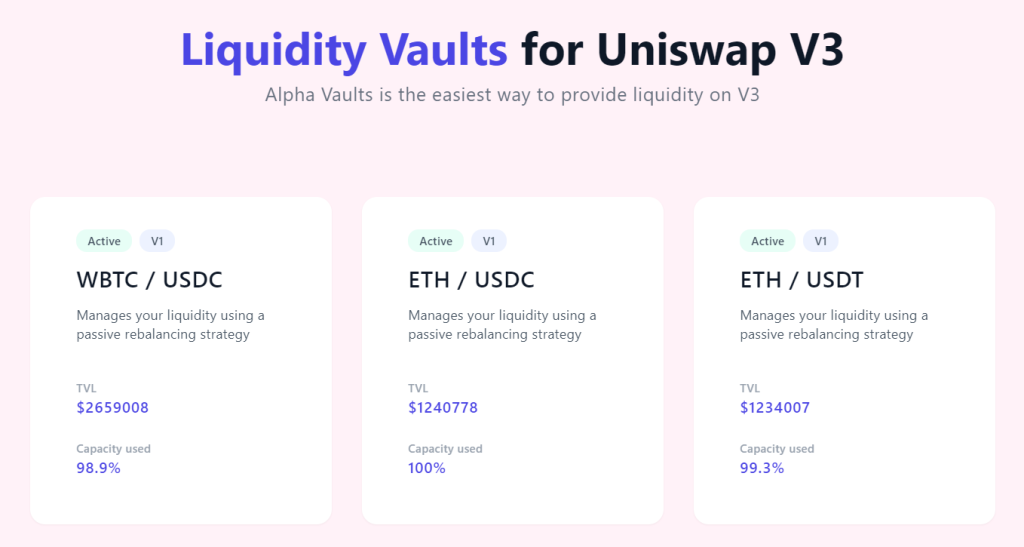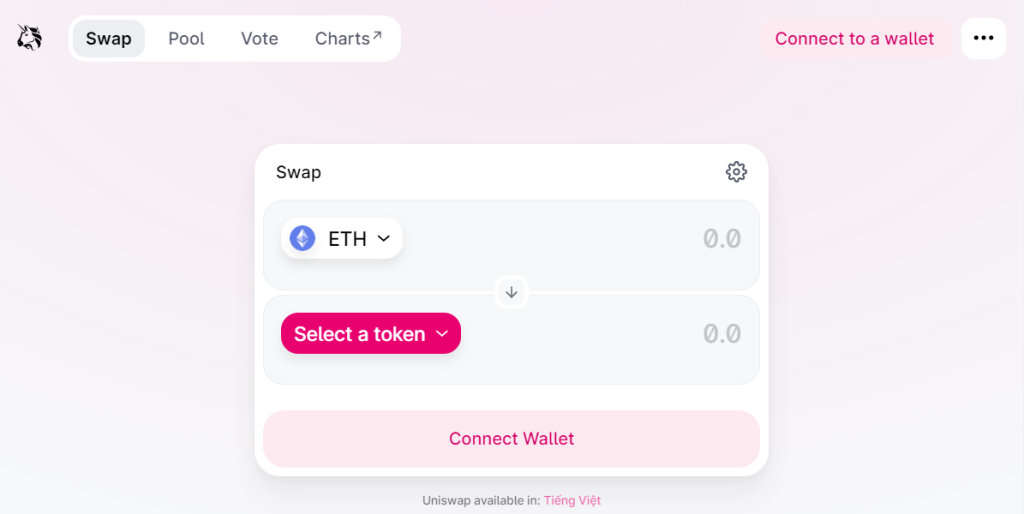
In Uniswap V3, the fee structure includes three tiers: 0.05%, 0.30%, and 1.00%. These tiers allow liquidity providers to choose the fee rate that best matches the volatility and characteristics of the asset pairs they support. This flexibility helps optimize trading costs for users and maximizes returns for liquidity providers.
Overview of Uniswap V3 Fees
Uniswap V3 introduces a dynamic fee structure designed to enhance liquidity provision and optimize trading costs. The new fee tiers allow liquidity providers to select a fee rate that best matches their risk and reward preferences, promoting a more efficient and flexible trading environment.
Introduction to Fee Tiers
Uniswap V3 offers multiple fee tiers, each tailored to different market conditions and asset characteristics:
- 0.05% Fee Tier: This tier is ideal for stablecoin pairs and other low-volatility assets. It offers minimal trading costs, attracting high-frequency traders and ensuring deep liquidity.
- 0.30% Fee Tier: This is the standard fee tier suitable for most trading pairs. It balances trading costs and liquidity provider rewards, making it a popular choice for a wide range of assets.
- 1.00% Fee Tier: This higher fee tier is designed for exotic or highly volatile asset pairs. It compensates liquidity providers for the increased risk associated with these assets, encouraging liquidity provision in less stable markets.
Importance of Fees in Liquidity Provision
Fees play a critical role in incentivizing liquidity provision on Uniswap V3:
- Revenue for Liquidity Providers: Fees are the primary source of income for liquidity providers. Higher fees can attract more liquidity by offering greater potential earnings, while lower fees can increase trading volume by reducing transaction costs.
- Market Stability: Appropriate fee tiers help maintain market stability by balancing the interests of traders and liquidity providers. Lower fees encourage more trading activity, while higher fees ensure that liquidity providers are adequately compensated for their risks.
- Liquidity Depth: By offering multiple fee tiers, Uniswap V3 ensures that there is sufficient liquidity across various market conditions. This flexibility allows liquidity providers to allocate their capital more effectively, enhancing overall market depth and reducing price slippage for traders.

Fee Tiers in Uniswap V3
Uniswap V3 introduces a novel approach to fees by allowing liquidity providers to choose from multiple fee tiers. This flexibility caters to different types of assets and market conditions, ensuring an optimal balance between trading volume and liquidity provision.
0.05% Fee Tier
The 0.05% fee tier is specifically designed for stablecoin pairs and other low-volatility assets:
- Minimal Trading Costs: This tier offers the lowest trading fees, making it attractive for high-frequency trading and arbitrage strategies.
- Stablecoin Pairs: It’s ideal for pairs like USDC/USDT, where price fluctuations are minimal, and large volumes of trade are common.
- Deep Liquidity: By encouraging higher trading volumes, this fee tier helps maintain deep liquidity and tight spreads, benefiting traders who need to execute large orders with minimal slippage.
0.30% Fee Tier
The 0.30% fee tier is the standard option on Uniswap V3 and suits a broad range of assets:
- Balanced Approach: This tier strikes a balance between low trading costs and attractive earnings for liquidity providers.
- Wide Applicability: It is suitable for most trading pairs, including both relatively stable assets and those with moderate volatility.
- Optimal for Many Traders: The 0.30% fee is familiar to many users from Uniswap V2, providing a predictable and reliable option for liquidity provision and trading.
1.00% Fee Tier
The 1.00% fee tier targets exotic or highly volatile asset pairs:
- Higher Compensation: This tier compensates liquidity providers for the increased risk associated with volatile assets, providing a higher potential return.
- Risk Management: It is ideal for assets that experience significant price swings, where liquidity providers need to be compensated for the risk of impermanent loss.
- Niche Markets: This fee tier helps to attract liquidity to less stable or emerging market pairs, ensuring that even these markets have sufficient liquidity for trading activities.
Choosing the Right Fee Tier
Selecting the appropriate fee tier on Uniswap V3 is crucial for optimizing returns and managing risk. The choice of fee tier depends on several factors that influence both trading efficiency and liquidity provision.
Factors to Consider
When choosing a fee tier, consider the following factors:
- Asset Volatility: Higher volatility assets benefit from higher fee tiers to compensate for increased risks. Stable assets with low volatility are best suited for lower fee tiers.
- Trading Volume: Assets with high trading volumes may perform better with lower fee tiers, as the increased number of transactions can offset the lower fee rate.
- Market Conditions: Current market conditions, such as overall market sentiment and liquidity levels, can influence the optimal fee tier. In volatile markets, higher fee tiers might be more appropriate.
- Liquidity Demand: Assess the demand for liquidity in specific asset pairs. High-demand pairs can sustain lower fees, while niche markets may require higher fees to attract sufficient liquidity.
- Competitive Landscape: Analyze the fee structures of competing platforms and pools. Choosing a fee tier that aligns with or improves upon competitors can attract more traders and liquidity providers.
Impact on Liquidity Providers
The chosen fee tier has significant implications for liquidity providers:
- Earnings Potential: Higher fee tiers generally offer greater earnings potential, compensating providers for the risk of providing liquidity to volatile asset pairs. However, they may result in lower trading volumes.
- Risk Management: Higher fee tiers can mitigate risks such as impermanent loss by providing higher returns. Lower fee tiers might be more stable but offer less compensation for potential losses.
- Capital Efficiency: The fee tier affects how efficiently liquidity providers can use their capital. Lower fee tiers might attract more trades, increasing the utilization of provided liquidity.
- Market Participation: Different fee tiers can influence the level of market participation. Lower fees encourage more trading activity, while higher fees can ensure liquidity for less active or riskier markets.
- Strategic Flexibility: Liquidity providers can strategically choose fee tiers to match their risk appetite and market expectations, allowing for dynamic adjustments based on changing conditions.

How Fees Affect Traders
Fees play a crucial role in the trading experience on Uniswap V3. Understanding how fees impact transaction costs and price slippage is essential for making informed trading decisions.
Transaction Costs
Transaction costs are directly influenced by the fee tier applied to trades on Uniswap V3:
- Lower Fees: Choosing pairs with lower fee tiers (e.g., 0.05%) can significantly reduce transaction costs, making frequent trading and arbitrage strategies more feasible.
- Higher Fees: Higher fee tiers (e.g., 1.00%) increase transaction costs, which might be justified for trades involving highly volatile or exotic assets where liquidity providers require higher compensation for risk.
- Cumulative Effect: Over multiple trades, the impact of fees accumulates, potentially reducing overall trading profitability. Traders need to factor in these costs when planning their trading strategies.
Price Slippage
Price slippage occurs when the executed price of a trade differs from the expected price due to changes in liquidity and market conditions. Fees influence slippage in several ways:
- Liquidity Depth: Lower fee tiers generally attract more liquidity, which can reduce slippage by providing deeper liquidity pools. Traders benefit from more stable pricing and better execution.
- Market Impact: In pairs with higher fees, the reduced trading volume might lead to shallower liquidity, increasing the likelihood of slippage, especially for large orders.
- Trade Size: Larger trades are more susceptible to slippage, as they can consume more of the available liquidity at the best prices. Lower fees can mitigate this effect by encouraging more liquidity provision.
- Fee Consideration: Traders must account for fees as part of their total transaction cost. Even if slippage is low, high fees can negate the benefits of good price execution.

Fee Distribution Among Liquidity Providers
Uniswap V3’s fee structure not only impacts traders but also significantly affects liquidity providers. Understanding how fees are distributed and the potential earnings can help liquidity providers make more informed decisions.
Earning Potential
The earning potential for liquidity providers on Uniswap V3 is influenced by several factors related to the fee structure:
- Fee Tiers: Different fee tiers (0.05%, 0.30%, 1.00%) offer varying levels of earnings potential. Higher fee tiers generally provide higher returns but come with increased risk.
- Trade Volume: The amount of trading activity in a liquidity pool directly affects earnings. Pools with higher trade volumes generate more fees, increasing potential earnings for liquidity providers.
- Liquidity Concentration: By concentrating liquidity in specific price ranges, liquidity providers can enhance their capital efficiency and maximize earnings within those ranges.
- Market Conditions: Volatile markets can lead to higher trading volumes and more frequent fee generation, increasing the earning potential for liquidity providers.
Fee Allocation Mechanism
Uniswap V3 employs a systematic mechanism to allocate fees among liquidity providers, ensuring fair distribution based on their contributions:
- Proportional Distribution: Fees are distributed proportionally to liquidity providers based on their share of the total liquidity in the pool. Larger contributions result in a higher share of the generated fees.
- Time-Weighted Earnings: Earnings are calculated based on the duration liquidity is provided in the pool. Providers who keep their assets in the pool longer are entitled to a proportionally higher share of the fees.
- Dynamic Adjustments: As trades occur and liquidity positions change, the fee allocation dynamically adjusts to reflect the current distribution of liquidity. This ensures that providers are fairly compensated for their ongoing contributions.
- Fee Reinvestment: Liquidity providers can choose to reinvest their earned fees back into the pool, compounding their returns and increasing their share of future fees.

Comparing Uniswap V2 and V3 Fees
Uniswap V3 introduces several changes and enhancements to the fee structure compared to Uniswap V2. These differences are designed to improve the efficiency and flexibility of liquidity provision and trading.
Differences in Fee Structures
The fee structures of Uniswap V2 and V3 have several key differences:
- Single Fee Tier in V2: Uniswap V2 uses a flat 0.30% fee on all trades, which is distributed to liquidity providers.
- Multiple Fee Tiers in V3: Uniswap V3 introduces three distinct fee tiers (0.05%, 0.30%, 1.00%), allowing liquidity providers to choose the fee level that best suits the volatility and characteristics of the asset pair they are providing liquidity for.
- Concentrated Liquidity in V3: Uniswap V3 allows liquidity providers to concentrate their liquidity within specific price ranges, making fee earnings more efficient and targeted compared to the uniform liquidity distribution in V2.
- Customizable AMM in V3: The customizable automated market maker (AMM) settings in V3 give providers more control over their liquidity positions and the fees they can earn.
Benefits of V3 Fee Tiers
The multiple fee tiers in Uniswap V3 offer several benefits over the single-tier system in V2:
- Greater Flexibility: Liquidity providers can select the fee tier that matches their risk tolerance and market strategy, optimizing their potential returns based on the specific characteristics of the asset pair.
- Enhanced Capital Efficiency: By allowing liquidity providers to concentrate their liquidity in active price ranges, V3 maximizes capital efficiency, leading to higher earnings from trading fees.
- Reduced Slippage: The ability to concentrate liquidity reduces slippage for traders, as there is more liquidity available at key price points, improving the overall trading experience.
- Increased Earnings Potential: Higher fee tiers (e.g., 1.00%) compensate liquidity providers for the risks associated with volatile or exotic assets, potentially increasing their earnings compared to the flat fee in V2.
- Adaptability to Market Conditions: The flexibility to choose different fee tiers allows liquidity providers to adapt to changing market conditions, ensuring they can maintain profitability in various market environments.
- Balanced Incentives: The tiered fee structure aligns incentives between liquidity providers and traders, encouraging more liquidity provision and higher trading volumes in stable markets while ensuring adequate compensation for riskier trades.

Strategies for Maximizing Returns
Uniswap V3 offers a range of strategies for liquidity providers to maximize their returns. By understanding and leveraging the different features of V3, providers can optimize their earnings while managing risks effectively.
Optimal Fee Tier Selection
Selecting the right fee tier is crucial for maximizing returns on Uniswap V3. Liquidity providers should consider several factors when choosing a fee tier:
- Asset Volatility: Higher fee tiers (e.g., 1.00%) are suitable for highly volatile or exotic assets, compensating for the increased risk. Conversely, stable pairs may benefit from lower fee tiers (0.05% or 0.30%) to attract more trading volume.
- Trading Volume: Pairs with high trading volumes can generate substantial fees even at lower fee tiers. Providers should analyze historical trading data to identify the most profitable fee tier for each asset pair.
- Market Conditions: Adjusting fee tiers based on market conditions can help maximize returns. During periods of high volatility, higher fee tiers can protect against impermanent loss and ensure adequate compensation for risk.
Managing Liquidity and Risk
Effective liquidity management is essential for maximizing returns on Uniswap V3. Providers should implement the following strategies to optimize their positions and manage risk:
- Concentrated Liquidity: By concentrating liquidity within specific price ranges, providers can increase capital efficiency and earn more fees. This strategy requires careful monitoring of price movements and adjustments to maintain optimal positions.
- Dynamic Rebalancing: Regularly rebalancing liquidity positions helps providers adapt to changing market conditions. This involves moving liquidity to active price ranges and adjusting fee tiers as needed.
- Diversification: Spreading liquidity across multiple pairs and fee tiers can reduce risk and increase overall returns. Diversification helps providers mitigate the impact of adverse price movements in any single asset pair.
- Monitoring Impermanent Loss: Impermanent loss occurs when the price of assets in a liquidity pool diverges. Providers should monitor and manage impermanent loss by adjusting their positions and using strategies like dynamic rebalancing.
- Utilizing Advanced Tools: Several tools and platforms offer analytics and automation features to help providers manage their liquidity positions. These tools can provide insights into optimal fee tier selection, impermanent loss management, and other strategies to maximize returns.